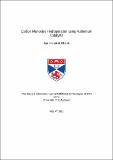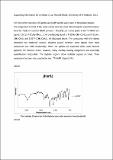Files in this item
Carbon monoxide hydrogenation using ruthenium catalysts
Item metadata
| dc.contributor.author | Blank, Jan Hendrik | |
| dc.coverage.spatial | 283 | en_US |
| dc.date.accessioned | 2013-04-05T14:25:05Z | |
| dc.date.available | 2013-04-05T14:25:05Z | |
| dc.date.issued | 2012-11-30 | |
| dc.identifier | uk.bl.ethos.570546 | |
| dc.identifier.uri | https://hdl.handle.net/10023/3470 | |
| dc.description.abstract | In this dissertation we investigate aspects of the Ru/[PBu₄]Br mixture in the homogeneous conversion of CO and H₂ as pioneered by Knifton, Dombek and Gresham. In chapter 1 we present a current overview of the literature on this subject. In chapter 2 we establish benchmark reactions and a full analysis of the liquid products that are generated during catalysis. The product mixture consists primarily of small alcohols (linear), acetic acid ethers, esters, and ethylene glycol. Both methanol and EG are formed independently, but methanol is then converted into almost all other products that we find. In chapter 3, the gas phase activity is assessed, and it is found that the Ru/[PBu₄]Br system is highly active for the WGS reaction, and as a result the reactor gas phase changes in composition over time. Following this, in chapter 4 the orders in p[sub](H2) and p[sub](CO) are determined for both the methanol formation reaction and the methanol homologation reaction. In order to achieve this, a simple kinetic model is developed to assess the relative reactivity of the system for each reaction. Using these orders and the knowledge of fast Water-Gas-Shift activity, we iteratively model the conditions in the reactor to closely fit and predict the methanol levels during the reaction. In chapter 5 the discovery of a promoter, [HPBu₃]Br is discussed. The promoter dissociates under catalysis conditions into HBr and PBu₃. The HBr then proceeds to improve catalysis by changing the catalyst composition, while the PBu₃ inhibits the homologation reaction selectively. In chapter 6 we proceed to test the activity of the system for a range of different promoters and solvents. The effect of bromide concentration, changing the halide, and using various acid promoters is tested. At last we attempt to expand on the scope of this reaction by using different ruthenium precursors and by using dimethyl ether as a reagent instead of methanol. Both seem effective. Notably, the conversion of CO₂ to methanol in a one-pot reaction was observed. | en |
| dc.language.iso | en | en_US |
| dc.publisher | University of St Andrews | |
| dc.rights | Creative Commons Attribution-NonCommercial-NoDerivs 3.0 Unported | |
| dc.rights.uri | http://creativecommons.org/licenses/by-nc-nd/3.0/ | |
| dc.subject | Ionic liquids | en_US |
| dc.subject | Homogeneous catalysis | en_US |
| dc.subject | Ruthenium | en_US |
| dc.subject | Syngas | en_US |
| dc.subject | Phosphonium salts | en_US |
| dc.subject | Oxygenates | en_US |
| dc.subject | High pressure | en_US |
| dc.subject.lcc | QD281.H8B6 | |
| dc.subject.lcsh | Hydrogenation | en_US |
| dc.subject.lcsh | Carbon monoxide | en_US |
| dc.subject.lcsh | Platinum group catalysts | en_US |
| dc.subject.lcsh | Ruthenium compounds | en_US |
| dc.title | Carbon monoxide hydrogenation using ruthenium catalysts | en_US |
| dc.type | Thesis | en_US |
| dc.contributor.sponsor | Eastman Chemical Company | en_US |
| dc.type.qualificationlevel | Doctoral | en_US |
| dc.type.qualificationname | PhD Doctor of Philosophy | en_US |
| dc.publisher.institution | The University of St Andrews | en_US |
This item appears in the following Collection(s)
Except where otherwise noted within the work, this item's licence for re-use is described as Creative Commons Attribution-NonCommercial-NoDerivs 3.0 Unported
Items in the St Andrews Research Repository are protected by copyright, with all rights reserved, unless otherwise indicated.



